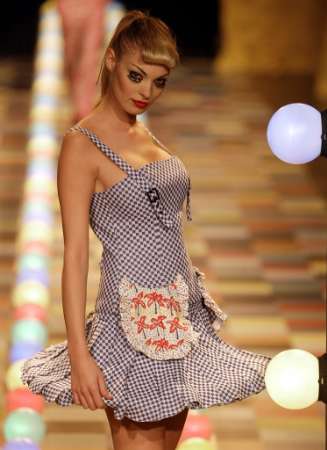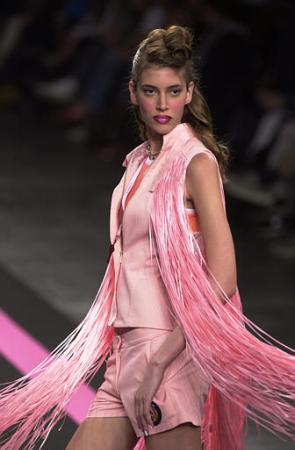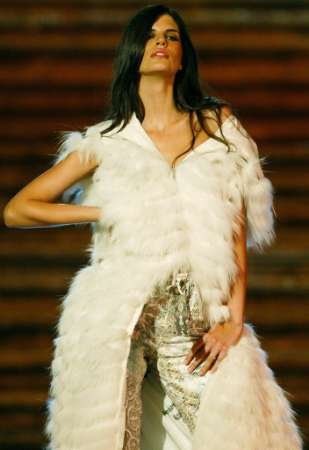|
Stardate
20020724.1332 (On Screen): I have no fashion sense, none whatever. For me, clothes are completely practical. They cover me, keep me from being arrested, and protect me from the sun. (I have extremely fair skin, and I burn like nobody's business.) Pants give me pockets to carry things.
Jeans and T-shirts are the ideal forms of clothing. They're comfortable, practical, easily cared for, and not particularly ugly.
I last wore my suit for my last job interview, and I don't even know if it fits any more. Anyway, it's probably out of fashion anyway, with lapels the wrong width or something like that. But I couldn't tell you, because I'm fashion-blind.
Still, I do have enough esthetic sensibility to be able to recognize when someone else has managed to put together a set of clothing which is striking and flattering. I can tell that they did a good job, but I can't tell you how, because I don't know how fashion works.
I can see the people around me who wear practical clothes like I do, and I also see people who wear what are evidently "fashionable" clothes, whether they actually look good or not. But I never see anyone wearing clothes like these:
       
I don't know fashion, but I do know that no-one wears clothes like this, not even for special events. They don't even wear this kind of thing to the Academy Awards.
Yet every year, top-bracket fashion designers turn out these things and hold high-profile fashion shows in Rio and Paris and Rome and New York, and the rich and famous flock to the shows.
What is going on? If no-one is wearing these things, who's buying them? If they're not being bought, where's the money coming from to pay for these extravaganzas? While access to these shows is a very exclusive privilege, tickets don't cost money. But the shows definitely do, so where's it coming from?
So here's the confused plebeian engineer trying to come up with a rationale for all this, and I believe I've found it: these aren't really clothes. What we're seeing is an extreme form of "modern art". They're sculpture in cloth and other flexible materials designed to fit the bodies of anorexic young women. Those attending these shows aren't shopping for things to wear, they're art patrons. These things do indeed get purchased, at very high price, but as collectibles and as a means of subsidizing what is viewed as being high art.
That's the only way I can make sense of this.
Anyway, I'd rather attend the Victoria's Secret fashion show if I had a choice. At least that's practical.
Update: Several people have written with plausible explanations. Ken writes:
Someone once explained to me though, that these things are a lot like auto shows, and the outfits worn are like concept cars. The fashions, like the concept cars, are not intended for anyone to buy, and they are rarely, if ever, mass produced using all the features of the prototype. But both show off new individual aesthetic and functional features which eventually, if the marketing experiment shows signs of success, are incorporated into normal product lines.
Someone who signed his letter with all consonants said:
Although high fashion is artistic, I donít think itís ďartĒ in the sense of something done for its own sake. I think itís an elaborate form of advertising. While these fashion houses donít (as far as I know) make money by selling the exotic items you have pictured, they do sell clothing that is somewhat more mainstream and very expensive. There is, of course, no practical reason to buy such clothing. People buy it because they think itís hip and prestigious. How do you make people think that your clothing is hip and prestigious? One way is to stage an event where celebrities and magazine editors gather and ooh and aah over your work (and get photographed doing it). I think this form of advertising is similar to Honda sponsoring a formula one car or Rossignol providing equipment to an Olympic skier. Most people donít drive 200 miles per hour or race through a slalom course, but they engage in more mundane versions of those activities, and it is hoped that seeing a companyís products used in high-profile events will engender an impression of quality.
Ryan Olson writes:
the designers design the over-the-top clothing for the runway shows. They then sell expensive made-to-order toned down versions of their fashions to very rich people, based on what was shown on the runway. The cuts, fabrics, and styles then filter down and influence the ready-to-wear fashions that fashion-conscious upper-middle-class folks buy at expensive department stores.
Me, I'd still rather go to the Victoria's Secret show.
|